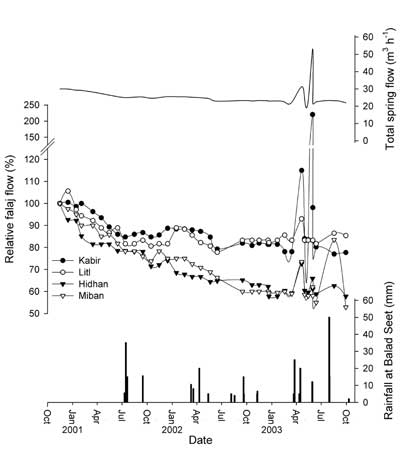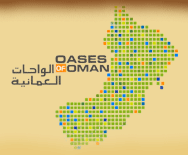Hydrological sustainability of mountain oases
Objectives: Assess the hydrological sustainability of mountain oases by determining spring flows and water ages
Contact Person: Prof. Dr. Andreas Bürkert, Institute of Crop Science, University of Kassel, Germany
Email: tropcrops@uni-kassel.de
Scientific staff: Dr. Eike Luedeling, Dr. Stefan Siebert, Dr. Hany El-Gamal, Dr. Maher Nagieb, Prof. Dr. Werner Aeschbach-Hertig, Prof. Dr. Rolf Kipfer
Study area: Mountains of Northern Oman
Duration: 2001-2008
Water ages and spring flows
To endure the long periods of drought that are typical of Oman’s climate, all oases require a mechanism to store water and gradually dispense it. The functioning of this mechanism is one of the primary determinants of the hydrologic sustainability of Omani oases. To quantify their hydrologic sustainability, the flow dynamics of four irrigation channels at Balad Seet, 22 at Maqta and two at Al ‘Ayn were measured over periods of between 19 and 34 months. Measurements were taken between 2000 and 2003 at Balad Seet and Maqta and in 2006 and 2007 at Al ‘Ayn (Fig. 1). This information was supplemented by determining water ages, the time between infiltration of rainfall and re-emergence as spring water, of water samples taken from two springs at Balad Seet, six springs at Maqta, and one spring each at Al ‘Ayn, As Sumayiyyah and Nakhl. Water ages were determined using the ³H-³He method and the SF6 method.

Figure 1. Map of the study locations in northern Oman.
Water flows varied between 22 and 58 m³ h-1 at Balad Seet (Fig. 2), between 4 and 9 m³ h -1 at Maqta and between 25 and 61 m³/h at Al ‘Ayn. During dry spells, spring flow decreased by 12% a-1 at Balad Seet and 30% a-1 at Maqta. Water ages ranged between 2 and 10 years for Balad Seet, between 2 and 8 years for Maqta and around 8 years for all other springs. For Nakhl, no reliable water age could be determined due to high amounts of radiogenic helium in the sample. As for one sample from Maqta, the age of this sample was assumed to be >15 years.
Determining water ages was difficult in many cases, because of unsaturated flow conditions in the limestone aquifers and probably natural sources of SF6. These complications underscore the importance of using more than one tracer for water dating. All studied oases seem capable of enduring droughts of about five years relatively unharmed, but longer droughts should have severe effects on agricultural production at Balad Seet, Al ‘Ayn and especially at Maqta.

Figure 2. Total spring flow, flow of individual irrigation canals and rainfall at Balad Seet over the study period.
Publications
 |
Luedeling, E., Nagieb, M., Wichern, F., Brandt, M., Deurer, M. & Buerkert, A. 2005. Drainage, salt leaching and physico-chemical properties of irrigated man-made terrace soils in a mountain oasis of northern Oman. Geoderma 125 (3-4), 273-285.
|
| |
LUEDELING E, EL-GAMAL H, AESCHBACH-HERTIG W, KIPFER R, NAGIEB M and BUERKERT A, 2007 (in preparation). Hydrological sustainability of mountain oases in northern Oman.
|
 |
Siebert, S., Nagieb, M. and Buerkert, A. 2007. Climate and irrigation water use of a mountain oasis in northern Oman. Journal of Agricultural Water Management 89, 1-14.
|
|
|
|
|
| |
|
| |
|
|



